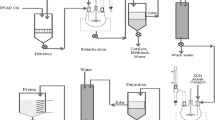Abstract
Esterification of succinic acid with oleyl alcohol catalyzed by immobilized Candida antarctica lipase B (Novozym 435) was investigated in this study. Response surface methodology (RSM) based on a five-level, four-variable central composite design (CCD) was used to model and analyze the reaction. A total of 21 experiments representing different combinations of the four parameters including temperature (35–65°C), time (30–450 min), enzyme amount (20-400 mg), and alcohol:acid molar ratio (1:1-8:1) were generated. A partial cubic equation could accurately model the response surface with a R2 of 0.9853. The effect and interactions of the variables on the ester synthesis were also studied. Temperature was found to be the most significant parameter that influenced the succinate ester synthesis. At the optimal conditions of 41.1°C, 272.8 min, 20 mg enzyme amount and 7.8:1 alcohol:acid molar ratio, the esterification percentage was 85.0%. The model can present a rapid means for estimating the conversion yield of succinate ester within the selected ranges.




Similar content being viewed by others
References
Abdel-Fattah YR, Saeed HM, Gohar YM, El-Baz MA (2005) Improved production of pseudomonas aeruginosa uricase by optimization of process parameters through statistical esperimental designs. Process Biochem 40:1707–1714
Abdul Rahman MB, Zaidan UH, Basri M, Hussein MZ, Rahman RNZA, Salleh AB (2008) Enzymatic synthesis of methyl adipate ester using lipase from Candida rugosa immobilized on Mg, Zn and Ni of layered double hydroxides (LDHs). J Mol Catal B Enzym 50:33–39
Azim H, Dekhterman A, Jiang Z, Gross RA (2006) Candida antarctica lipase B-catalyzed synthesis of poly(butylene succinate): shorter chain building blocks also work. Biomacromolecules 7:3093–3097
Bhak G, Song M, Lee S, Hwang S (2005) Response surface analysis of solid state growth of Pleurotus ostreatus mycelia utilizing whey permeate. Biotechnol Lett 27:1537–1541
Gryglewicz S (2001) Enzyme catalyzed synthesis of some adipic esters. J Mol Catal B Enzym 15:9–13
Gunawan ER, Basri M, Abdul Rahman MB, Salleh AB, Rahman RNZA (2005) Study on response surface methodology of lipase catalyzed synthesis of palm-based wax ester. Enzyme Microb Technol 37:739–744
Jeong GT, Yang HS, Park DH (2009) Optimization of transesterification of animal fat ester using response surface methodology. Bioresour Technol 100:25–30
Jiang Z (2008) Lipase-catalyzed synthesis of aliphatic polyesters via copolymerization of lactone, dialkyl diester, and diol. Biomacromolecules 9:3246–3251
Lee DC, Park JH, Kim GJ, Kim HS (1999) Modeling, simulation, and kinetic analysis of a heterogeneous reaction system for the enzymatic conversion of poorly soluble substrate. Biotechnol Bioeng 64:272–283
Macedo GA, Pastore GM, Rodrigues MI (2004) Optimising the synthesis of isoamyl butyrate using Rhizopus sp. lipase with a central composite rotatable design. Process Biochem 39:687–692
McCabe RW, Taylor A (2004) An investigation of the acyl-binding site of Candida antarctica lipase B. Enzyme Microb Technol 35:393–398
McCarron PA, Woolfson AD, Keating SM (1999) Response surface methodology as a predictive tool for determining the effects of preparation conditions on the physicochemical properties of poly(isobutylcyanoacrylate) nanoparticles. Int J Pharm 193:37–47
McKinlay JB, Vieille C, Zeikus JG (2007) Prospects for a bio-based succinate industry. Appl Microbiol Biotechnol 76:727–740
Pavia DL, Lampman GM, Kriz GS (2009) Introduction to spectroscopy, 4th edn. Brooks/Cole Cengage Learning, Belmont, Australia, pp 477–478
Petersson AEV, Gustafsson LM, Nordblad M, Borjesson P, Mattiasson B, Adlercreutz P (2005) Wax esters produced by solvent-free energy-efficient enzymatic synthesis and their applicability as wood coatings. Green Chem 7:837–843
Radzi SM, Basri M, Salleh AB, Ariff A, Mohammad R, Abdul Rahman MB, Rahman RNZA (2005) High performance enzymatic synthesis of oleyl oleate using immobilised lipase from Candida antartica. Electron J Biotechnol 8:291–298
Sun SY, Xu Y (2009) Membrane-bound ‘synthetic lipase’ specifically cultured under solid-state fermentation and submerged fermentation by Rhizopus chinensis: A comparative investigation. Bioresour Technol 100:1336–1342
Twu YK, Shih IL, Yen YH, Ling YF, Shieh CJ (2005) Optimization of lipase-catalyzed synthesis of octyl hydroxyphenylpropionate by response surface methodology. J Agric Food Chem 53:1012–1016
Villeneuve P, Barea B, Sarrazin P, Davrieux F, Boulanger R, Caro Y, Figueroa-Epinoza MC, Graille J (2003) Synthesis of pyroglutamic acid fatty esters though lipase-catalysed esterification with medium chains alcohols. Enzyme Microb Technol 33:79–84
Wang D, Li Q, Li W, Xing J, Su Z (2009) Improvement of succinate production by overexpression of a cyanobacterial carbonic anhydrase in Escherichia coli. Enzyme Microb Technol 45:491–497
Zeikus JG, Jain MK, Elankovan P (1999) Biotechnology of succinic acid production and markets for derived industrial products. Appl Microbiol Biotechnol 51:545–552
Author information
Authors and Affiliations
Corresponding author
Additional information
This article is part of the BioMicroWorld 2009 Special Issue.
Rights and permissions
About this article
Cite this article
Abdul Rahman, M.B., Jarmi, N.I., Chaibakhsh, N. et al. Modeling and optimization of lipase-catalyzed production of succinic acid ester using central composite design analysis. J Ind Microbiol Biotechnol 38, 229–234 (2011). https://doi.org/10.1007/s10295-010-0817-3
Received:
Accepted:
Published:
Issue Date:
DOI: https://doi.org/10.1007/s10295-010-0817-3




